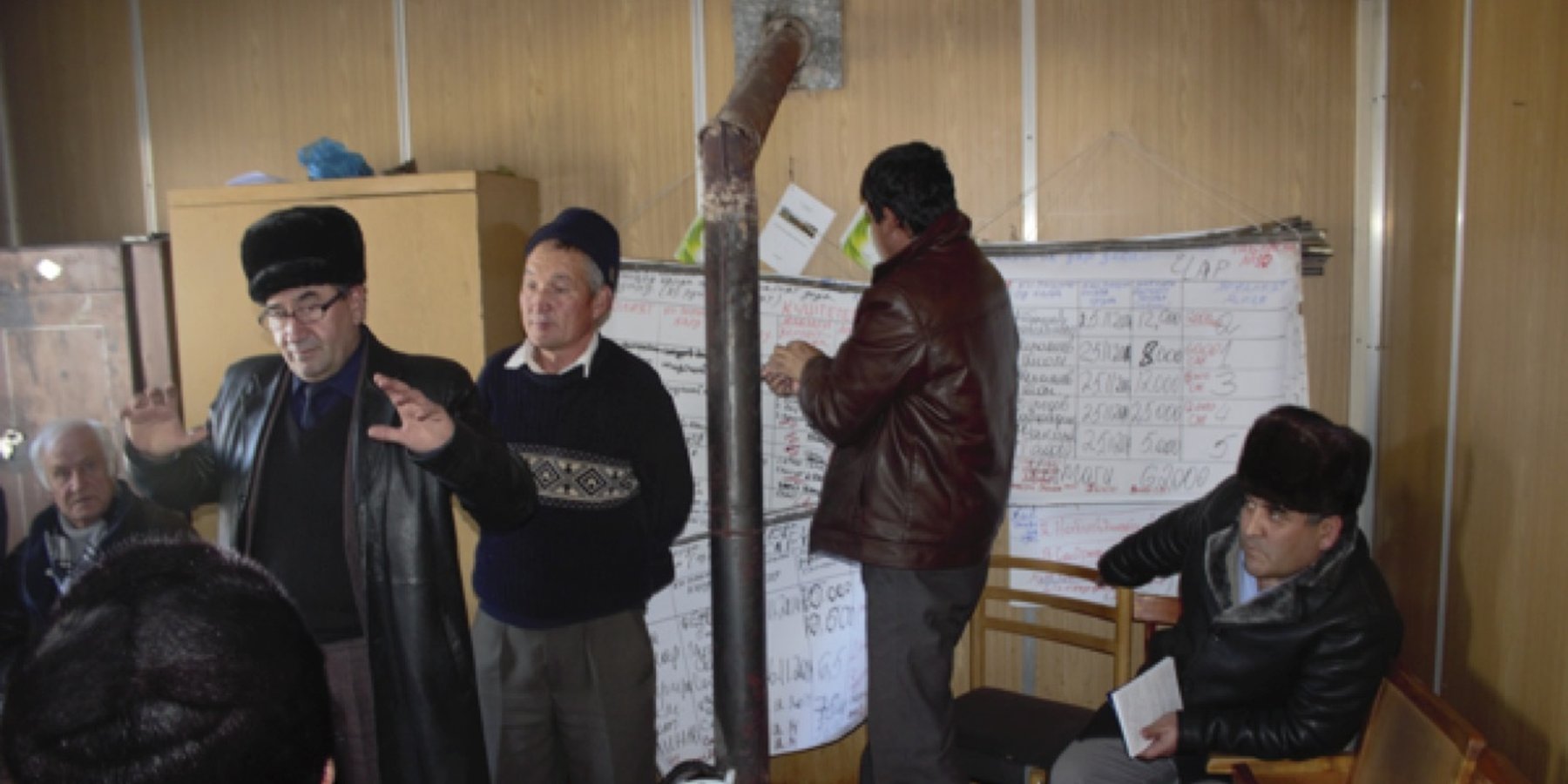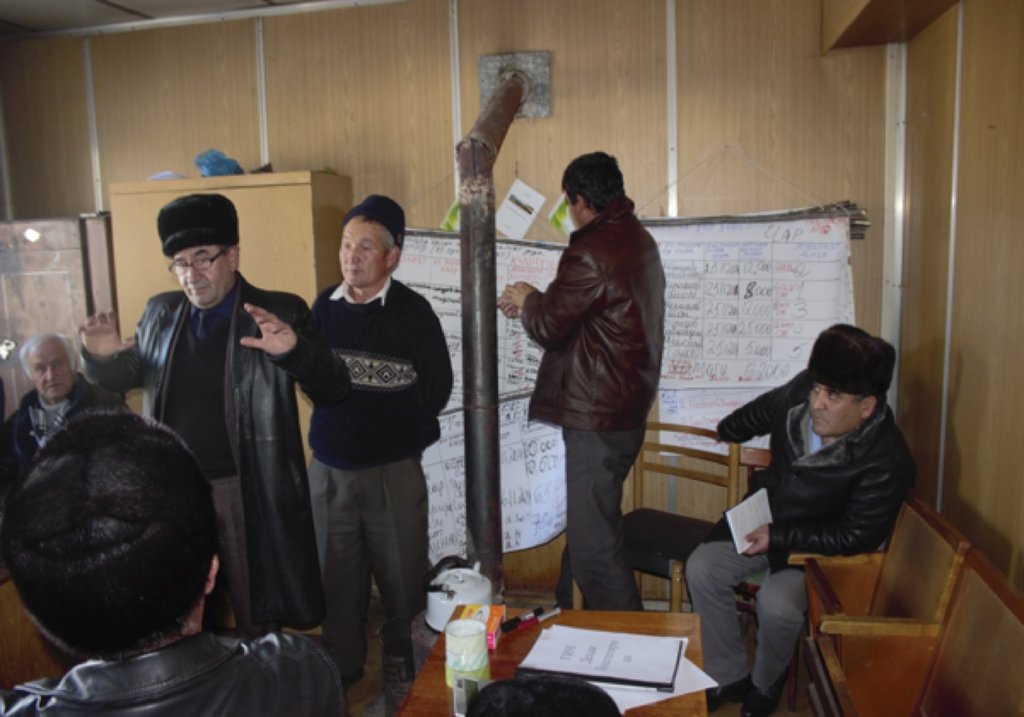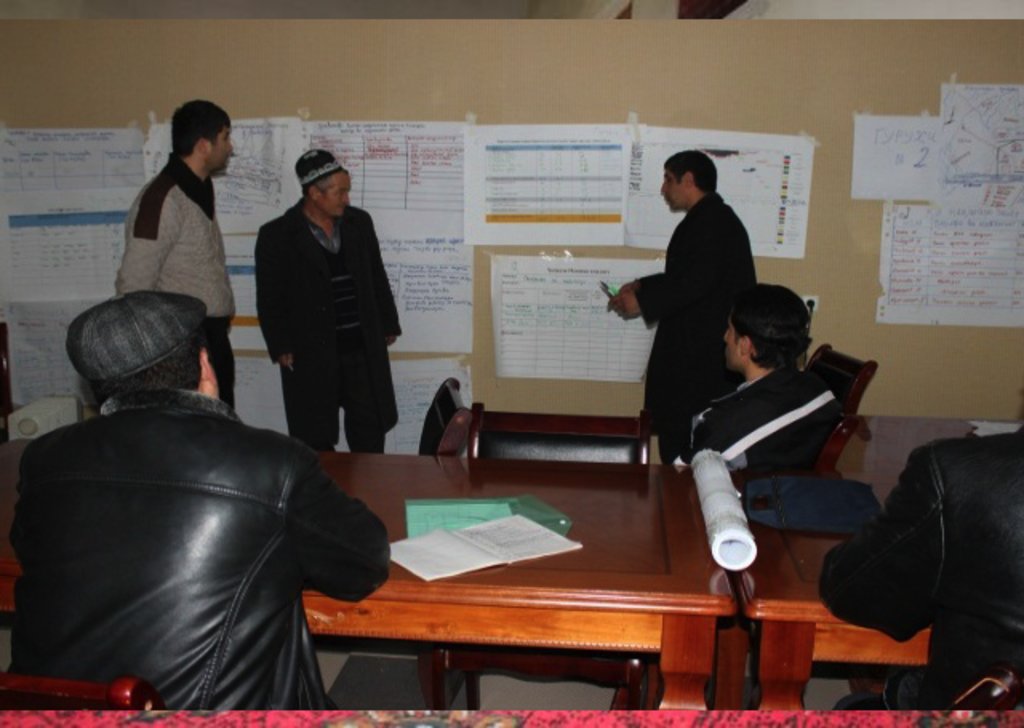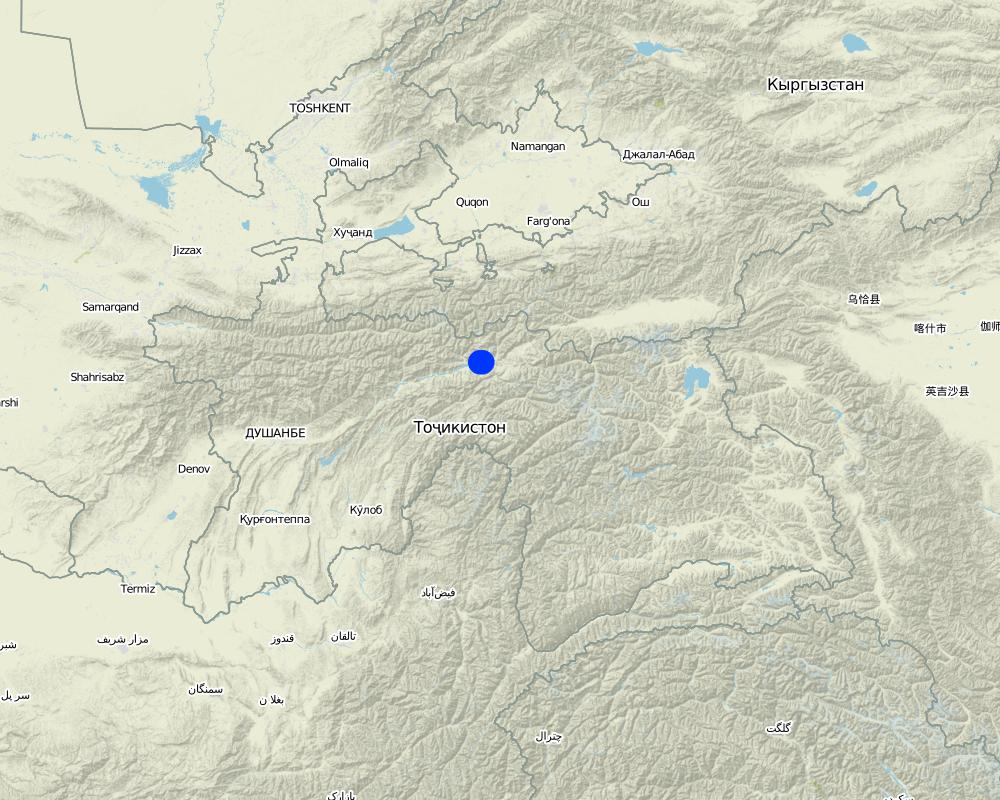Pasture and Livestock Management Plan [Tadjikistan]
- Création :
- Mise à jour :
- Compilateur : Askarsho Zevarshoev
- Rédacteur : –
- Examinateurs : Yacime Khadraoui, Maximilian Knoll
Накшаи Идоракунии Чорво ва Чарогох
approaches_3459 - Tadjikistan
Voir les sections
Développer tout Réduire tout1. Informations générales
1.2 Coordonnées des personnes-ressources et des institutions impliquées dans l'évaluation et la documentation de l'Approche
Nom du projet qui a facilité la documentation/ l'évaluation de l'Approche (si pertinent)
Environmental Land Management and Rural Livelihoods (ELMAR)Nom du ou des institutions qui ont facilité la documentation/ l'évaluation de l'Approche (si pertinent)
Aga Khan Foundation (Aga Khan Foundation) - Suisse1.3 Conditions relatives à l'utilisation par WOCAT des données documentées
Quand les données ont-elles été compilées (sur le terrain)?
15/07/2014
Le compilateur et la(les) personne(s) ressource(s) acceptent les conditions relatives à l'utilisation par WOCAT des données documentées:
Oui
1.4 Références au(x) questionnaire(s) sur les Technologies de GDT
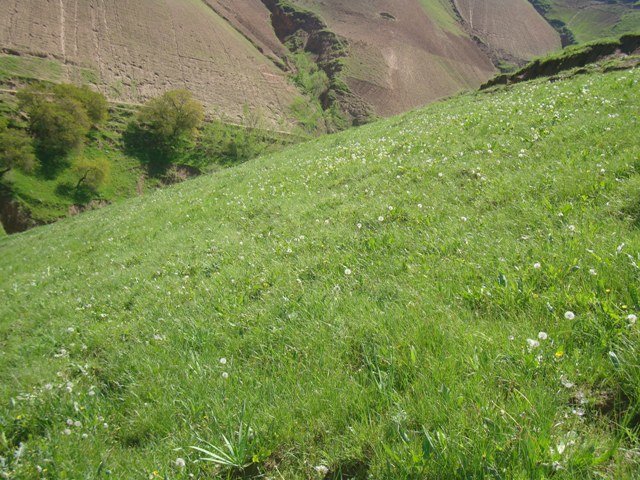
Rehabilitation of degraded pastures with alfalfa [Afghanistan]
Degraded pastures are restored with alfalfa through broad seeding method. The area is put under quarantine for three years to allow for the pasture to restore sufficiently.
- Compilateur : Bettina Wolfgramm
2. Description de l'Approche de GDT
2.1 Courte description de l'Approche
"Pasture and Livestock Management Plan" is a participatory approach which is guiding pasture users, members of Pasture User Unions and Pasture User Groups to develop their action plan on pasture and livestock management. The approach brings together stakeholders, who are involved at any stage in pasture management or can contribute to or impede the implementation of the pasture livestock management plan.
2.2 Description détaillée de l'Approche
Description détaillée de l'Approche:
Pasture and Livestock Management Plan (PLMP) Approach is a participatory approach towards the development of a pasture plan with communities to ensure a sustainable use of pasture resources. It was especially designed for the needs of the Pasture User Union, a new structure allowed to establish at community level to implement better management of their pasture resources. Though a step-by-step analysis of the current situation a community will come up with detailed action plan for the following three years. The PLMP involves, but is not limited to, the establishment of a committee involved in preparation of the PLMP, as well as a stakeholder analysis and the determination of the carrying capacity of pasture resources by comparing the existing fodder resources and requirements for the fodder. Based on that analysis, an action plan will be developed with involvement of all stakeholders to reach an agreement on approaches and technologies to implement the interventions. The PLMP will lead to the development of the Action Plan based on the discussion between different stakeholders. In the process of the plan development with consideration of an expert a clear roles and responsibilities of all involved actors/stakeholder in a defined timeframe will be identified.
The main objectives is to support land users with development of actions, which contribute to the sustainable development of pasture resource and livestock development. The central focus is given to balance the need of the livestock owners to improve livestock productivity with compromising the environmental conditions for the next generations and ecosystem services. The planning process should contribute to better management of pasture lands, rehabilitation of degraded pastures, resolving any existing conflict over pasture use, awareness raising on the role of pasture land for ecosystem services and overall trends in development with regards to use and management of pasture resources.
The process is based on participatory methods with involvement of different stakeholders capturing main principles for land use planning. The process includes pasture users/livestock owners who are involved in day to day management of pasture lands, local government with related department to pasture use, land owners, different departments of local government such as forestry, land use committee, environmental protection etc.
The approach is conducted in three main stages: In the firs stage consultation with pasture users will be held to identify the need for development of a pasture plan. Then an inventory of all land resources, including pasture land and livestock numbers will be conducted. In the third stage a workshop will be conducted with involvement of all stakeholders, where the pasture plan will be developed. In the final stage of the pasture plan development an action plan with defined clear activities in a given frame and assigned responsible persons will be developed.
Land users, who also own livestock appreciate their involvement in the pasture development planning. They also like when their voice is taken into consideration in making any decision with regards to the pasture use.
2.3 Photos de l'approche
Remarques générales concernant les photos:
Participants reflecting on the overall process of the PLMP approach with all steps involved starting with setting up objectives and principles, analysis of stakeholders up to development of action plan.
2.5 Pays/ région/ lieux où l'Approche a été appliquée
Pays:
Tadjikistan
Région/ Etat/ Province:
Rasht Valley/Lakhsh District
Autres spécifications du lieu :
PUUs established in Rasht Valley under ELMARLP
Map
×2.6 Dates de début et de fin de l'Approche
Si l'année précise est inconnue, indiquez approximativement quand l'Approche a démarré:
il y a moins de 10 ans (récemment)
2.7 Type d'Approche
- fondé sur un projet/ programme
2.8 Principaux objectifs de l'Approche
The main objective is to support land users with the development of actions, that contribute to the sustainable development of pasture resource and livestock development. The central focus is to balance the need of the livestock owners to improve livestock productivity without compromising the environmental conditions for next generations and ecosystem services. The planning process should contribute to better management of pasture lands, rehabilitation of degraded pastures, resolving any existing conflicts over pasture use, raise awareness on the role of pasture land for ecosystem services and overall trends in development with regards to use and management of pasture resources.
2.9 Conditions favorisant ou entravant la mise en œuvre de la(des) Technologie(s) appliquée(s) sous l'Approche
normes et valeurs sociales/ culturelles/ religieuses
- entrave
Communities are used to an ad hoc use of natural resources and therefore sometime not willing to structured planning processes in terms of use of pasture resources.
disponibilité/ accès aux ressources et services financiers
- entrave
In the case that funding is not available from project side, it may hinder further implementation of the actions planned under the PLMP approach.
cadre institutionnel
- favorise
The PLMP approach is specifically designed for the PUU, which are legally registered institutes under the governmental law. This enables the process to run continously.
collaboration/ coordination des acteurs
- favorise
Depending on the leadership of the institutional structure, if well managed, it can enable collaboration among different stakeholders
- entrave
The newly established PUUs do not have enough power to influence the institutes in which stakeholders who are not interested in the sustainable use of pasture resources work hinder the planning process.
cadre juridique (régime foncier, droits d'utilisation des terres et de l'eau)
- favorise
mainly used by the PUUs, which are are functioning in the framework of state law
cadre politique
- favorise
The plan is developed for the Pasture User Unions, which are legal structure responsible for pasture management at community level.
gouvernance foncière (prise de décisions, mise en œuvre et application des décisions)
- favorise
The approach will enable community members (PUUs) to become legal owners of the pasture resources according to the Pasture Law of the Republic of Tajikistan.
connaissances sur la GDT, accès aux supports techniques
- favorise
Experts in the field are supported technically by project consultants, several trainings on the process and approach are conducted for them.
3. Participation et rôles des parties prenantes impliquées dans l'Approche
3.1 Parties prenantes impliquées dans l'Approche et rôles
- exploitants locaux des terres / communautés locales
livestock owners and PUU members
involved in direct process development and implementation of the approach
- organisations communautaires
village organizations, pasture user unions
also registered in the framework of the state law and are represented in the PUU. mainly involved in mobilization of the community to participate in the development and implementation of the plan
- Spécialistes de la GDT/ conseillers agricoles
project consultants and technical staff
facilitate the process of developing the PLMP approach, capacity building on the approach for the members of PUU
- ONG
locally registered public organizations which are directly involved in the natural resource and environmental management
provide technical support to the community and land users; can also support with fundraising
- secteur privé
entrepreneurs at local level
co-funding of the implementation of some of the practices from the PLMP
- gouvernement local
local level government (sub-district authority), land use committee, committee of environmental protection, agriculture department etc.,
as one of the main stakeholders responsible for management of natural resource; can also provide overall supervision of the approach development; PUUs for which the PLMP is developed: legal structure under the Pasture Law of the Republic of Tajikistan.
Si plusieurs parties prenantes sont impliquées, indiquez l'organisme chef de file ou l'institution responsable:
Land Commttee
3.2 Participation des exploitants locaux des terres/ communautés locales aux différentes phases de l'Approche
| Participation des exploitants locaux des terres/ communautés locales | Spécifiez qui était impliqué et décrivez les activités | |
|---|---|---|
| initiation/ motivation | soutien extérieur | livestock owners, PUU members; consultation with livestock owners, facilitation the process of establishment of PUUs |
| planification | interactive | land users, PUU members, pasture experts |
| mise en œuvre | interactive | PUU members and expert from project; consultation with stakeholders, conduct workshop and development of the plan |
| suivi/ évaluation | soutien extérieur | from project team and management of PUU |
3.4 Prises de décision pour la sélection de la Technologie/ des Technologies
Indiquez qui a décidé de la sélection de la Technologie/ des Technologies à mettre en œuvre:
- principalement les spécialistes de la GDT, après consultation des exploitants des terres
Expliquez:
Mainly as a new approach, best practices from the WOCAT database were used by the SLM specialists to introduce to land users and traditional practices were also applied based on the knowledge of land users.
Spécifiez sur quelle base ont été prises les décisions:
- l'évaluation de connaissances bien documentées en matière de GDT (prises de décision fondées sur des preuves tangibles)?
- expériences et opinions personnelles (non documentées)
4. Soutien technique, renforcement des capacités et gestion des connaissances
4.1 Renforcement des capacités/ formation
Une formation a-t-elle été dispensée aux exploitants des terres/ autres parties prenantes?
Oui
Spécifiez qui a été formé:
- exploitants des terres
- personnels/ conseillers de terrain
Formats de la formation:
- sur le tas
- réunions publiques
Thèmes abordés:
"Pasture and Livestock Management Plan" methodology, proposal development for fund raising, Environmental Land Management
4.2 Service de conseils
Les exploitants des terres ont-ils accès à un service de conseils?
Oui
Spécifiez si le service de conseils est fourni:
- dans les champs des exploitants?
Décrivez/ commentez:
During the project period continuos visits were organized to the project site to review the progress and provide advisory service. The project implmentation team consisting of different experts, including pasture, environmental specialists and monitoring and evaluation experts.
4.3 Renforcement des institutions (développement organisationnel)
Des institutions ont elles été mises en place ou renforcées par le biais de l'Approche?
- oui, beaucoup
Spécifiez à quel(s) niveau(x), ces institutions ont été renforcées ou mises en place:
- local
Décrivez l'institution, ses rôles et responsabilités, ses membres, etc.
Pasture User Union was established at sub-district level.
Précisez le type de soutien:
- financier
- renforcement des capacités/ formation
Donnez plus de détails:
Different technical and administrative trainings were provided and the PUU was funded with certain amount for implementation of the PLMP approach.
4.4 Suivi et évaluation
Le suivi et l'évaluation font ils partie de l'Approche? :
Oui
Commentaires:
The final section of the PLMP is monitoring and evaluation. At each stage a responsible person among the stakeholders is assigned to conduct the plan implementation. In addition, the project team also conducts monitoring of the approach.
Si oui, ce document est-il destiné à être utilisé pour le suivi et l'évaluation?
Oui
Commentaires:
The implementing agency has a monitoring methodology, which will be used by the project team to conduct monitoring.
4.5 Recherche
La recherche a-t-elle fait partie intégrante de l’Approche?
Non
5. Financement et soutien matériel externe
5.1 Budget annuel de la composante GDT de l'Approche
Si le budget annuel précis n'est pas connu, indiquez une fourchette:
- 2 000-10 000
Commentez (par ex. principales sources de financement/ principaux bailleurs de fonds):
World Bank in the framework of ELMARL - Environmental Land Management and Rural Livelihood project
5.2 Soutiens financiers/ matériels fournis aux exploitants des terres
Les exploitants des terres ont-ils reçu un soutien financier/ matériel pour la mise en œuvre de la Technologie/ des Technologies?
Non
5.3 Subventions pour des intrants spécifiques (incluant la main d'œuvre)
- aucun
Si la main d'œuvre fournie par les exploitants des terres était un intrant substantiel, elle était:
- volontaire
Commentaires:
This is traditional now and any project fund should be accompanied by contributions from communities, which is mainly labour on a voluntary basis
5.4 Crédits
Des crédits ont-ils été alloués à travers l'Approche pour les activités de GDT?
Non
5.5 Autres incitations ou instruments
D'autres incitations ou instruments ont-ils été utilisés pour promouvoir la mise en œuvre des Technologies de GDT?
Non
6. Analyses d'impact et conclusions
6.1 Impacts de l'Approche
Est-ce que l'Approche a autonomisé les exploitants locaux des terres, amélioré la participation des parties prenantes?
- Non
- Oui, un peu
- Oui, modérément
- Oui, beaucoup
It directly helped them to identify their status and understand their right to land use.
Est-ce que l'Approche a aidé les exploitants des terres à mettre en œuvre et entretenir les Technologies de GDT?
- Non
- Oui, un peu
- Oui, modérément
- Oui, beaucoup
All technologies planned under the approach as part of their action plan were later financed by projects to implement.
after development of the pasture and livestock management plan the PUUs were supported financial from the ELMARL project to implement the plan
the plan is developed through conducted workshop with participation of all stakeholders, including land users, where they get opportunity to learn experiences of other stakeholders.
All stakeholders involved in the process including women and youth had an opportunity to make decisions in line with other stakeholders.
Est-ce que l'Approche a atténué les conflits?
- Non
- Oui, un peu
- Oui, modérément
- Oui, beaucoup
Roles and responsibilities identified all stakeholder and one of the objective to mitigate conflict brought under discussion conflict over pasture use and tried to solve it to some extent.
Est-ce que l'Approche a autonomisé les groupes socialement et économiquement défavorisés?
- Non
- Oui, un peu
- Oui, modérément
- Oui, beaucoup
Women's role in livestock management was identified and empowered.
All stakeholders involved in the process including women and youth had an opportunity to make decisions in line with other stakeholders.
the approach give the land users/PUU members rights to become owner of the pasture under the Pasture Law of the Republic of Tajikistan
6.2 Principale motivation des exploitants des terres pour mettre en œuvre la GDT
- augmenter la production
- réduire la dégradation des terres
The rotation plan for rehabilitation of degraded pasture is applied.
- réduire les risques de catastrophe
Watershed approach was applied to ban grazing in some areas to prevent land slide and mudflow as a result of degradation.
- règles et règlements (amendes)/ application
The plan does not set certain rules at this stage to enforce the regulation, but the community is planning to negotiate and set certain rules in case of not following the regulations to implement the plan.
6.3 Durabilité des activités de l'Approche
Les exploitants des terres peuvent-ils poursuivre ce qui a été mis en œuvre par le biais de l'Approche (sans soutien extérieur)?
- incertain
Si non ou incertain, spécifiez et commentez:
depends on the availability of funding, leadership and support from other stakeholders, especially local government
6.4 Points forts/ avantages de l'Approche
| Points forts/ avantages/ possibilités du point de vue de l'exploitant des terres |
|---|
| active participation in the development of the plan |
| better understanding of the current situation with regards to pasture use and importance of pasture plan development |
| Points forts/ avantages/ possibilités du point de vue du compilateur ou d'une autre personne ressource clé |
|---|
| involvement of all stakeholders, especially land users and taking their knowledge and voice into consideration in decision making |
| building of the knowledge and opening a platform for collaboration between different stakeholders interested in sustainable management of pasture resources |
6.5 Faiblesses/ inconvénients de l'Approche et moyens de les surmonter
| Faiblesses/ inconvénients/ risques du point de vue de l’exploitant des terres | Comment peuvent-ils être surmontés? |
|---|---|
| time consuming, requires resource in the short term | should be understand as a means of livelihoods and spend more time, improve understanding of better gain in a long term |
| Faiblesses/ inconvénients/ risques du point de vue du compilateur ou d'une autre personne ressource clé | Comment peuvent-ils être surmontés? |
|---|---|
| financial resources | should design longer term project to attract funding before the approach becomes self sustained |
| low capacity of the stakeholders, | more trainings, sharing of experiences |
| human resources | More focus should be given to younger generation to build their capacity and involve them in the approach development |
7. Références et liens
7.1 Méthodes/ sources d'information
- visites de terrain, enquêtes sur le terrain
6
- interviews/entretiens avec les exploitants des terres
more than 50
- interviews/ entretiens avec les spécialistes/ experts de GDT
5
- compilation à partir de rapports et d'autres documents existants
3
7.2 Références des publications disponibles
Titre, auteur, année, ISBN:
Pasture and Livestock Management Plan Manual
Disponible à partir d'où? Coût?
Available upon request
7.3 Liens vers les informations pertinentes disponibles en ligne
Titre/ description:
Pasture Management Networking Platform (PMNP)
URL:
https://pasture.klink.asia/dms/documents/groups/796?page=2
Liens et modules
Développer tout Réduire toutLiens

Rehabilitation of degraded pastures with alfalfa [Afghanistan]
Degraded pastures are restored with alfalfa through broad seeding method. The area is put under quarantine for three years to allow for the pasture to restore sufficiently.
- Compilateur : Bettina Wolfgramm
Modules
Aucun module trouvé


